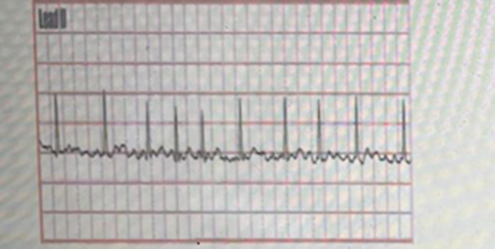A client with the rhythm below has been admitted into the cardiac icu. What assessment finding does the nurse expect to find in this client?

Hypertension
Indigestion
Eupnea
Irregular palpitations
The Correct Answer is D
A. Hypertension:
Hypertension is not directly related to the rhythm displayed in the image. The rhythm is suggestive of atrial fibrillation (AF), characterized by irregular and chaotic electrical activity, leading to irregular heartbeats. Hypertension can be a risk factor for AF but is not a typical presenting symptom.
B. Indigestion:
Indigestion is a non-specific symptom that may occur in cardiac events like myocardial infarction but is not a hallmark of atrial fibrillation. The rhythm strip does not indicate myocardial ischemia.
C. Eupnea:
Eupnea refers to normal breathing, which is not commonly associated with atrial fibrillation. Clients with AF may experience symptoms such as shortness of breath or fatigue rather than normal, unlabored breathing.
D. Irregular palpitations:
This is the most expected finding. Atrial fibrillation leads to an irregularly irregular pulse, which patients often describe as palpitations. This rhythm strip demonstrates the hallmark chaotic atrial activity and irregular ventricular response seen in AF.
Nursing Test Bank
Naxlex Comprehensive Predictor Exams
Related Questions
Correct Answer is B
Explanation
A) Unilateral upper extremity weakness:
Guillain-Barré Syndrome (GBS) typically presents with bilateral weakness, not unilateral. The weakness in GBS typically begins symmetrically in the lower extremities and ascends upward toward the upper body, including the arms, face, and respiratory muscles. Therefore, unilateral weakness is not characteristic of GBS, and its presence should prompt further investigation into other possible causes.
B) Bilateral ascending weakness:
One of the hallmark signs of Guillain-Barré Syndrome is ascending weakness, which means that the weakness usually starts in the lower extremities (legs) and progresses upwards to the upper extremities, face, and potentially the respiratory muscles. This bilateral ascending paralysis is a classic feature of GBS and occurs due to the immune system attacking the myelin sheath of peripheral nerves. The nurse should be vigilant for signs of progressive weakness, as GBS can quickly lead to respiratory failure and requires prompt intervention.
C) Mask-like facial expressions:
Mask-like facial expressions are more commonly associated with Parkinson's disease, not Guillain-Barré Syndrome. Parkinson’s disease is characterized by a reduction in facial expressiveness due to the loss of dopaminergic neurons, leading to a fixed, unblinking, or "masked" appearance. While facial involvement can occur in GBS as the weakness ascends, it is not typically described as a "mask-like" expression.
D) Pill rolling actions made by the client's fingers:
Pill-rolling is a characteristic tremor often associated with Parkinson's disease and involves the repetitive motion of the fingers, as if rolling a pill. It is a resting tremor seen in Parkinson's disease and not in Guillain-Barré Syndrome. GBS primarily presents as weakness and loss of motor function, rather than tremors or other involuntary movements.
Correct Answer is A
Explanation
A) Wear a dosimeter badge and lead apron when providing direct patient care: When caring for a patient undergoing internal radiation therapy (brachytherapy), radiation safety is the nurse’s priority. The nurse must take measures to minimize radiation exposure by wearing protective equipment such as a dosimeter badge (to monitor exposure levels) and a lead apron (to shield against radiation). These precautions are critical to protect healthcare workers from potential radiation harm while caring for a patient with a radiation implant.
B) Avoid placing a radiation sign at the entrance of the room for patient privacy: Placing a radiation warning sign at the entrance of the room is a mandatory safety protocol when a patient is undergoing brachytherapy. This warning sign informs healthcare personnel and visitors that radiation is present, and it is important for ensuring safety. Patient privacy should not override radiation safety protocols.
C) Alert family members that they should restrict their visiting to 60 minutes at a time: While it is essential to inform family members about safety precautions when visiting a patient receiving radiation therapy, the priority action for the nurse is to ensure their own safety and radiation exposure first. Limiting family visits is an important step to reduce unnecessary exposure, but this is a secondary concern compared to the nurse's direct radiation safety measures.
D) Explain to the patient that she will continue to emit radiation for months after the implant is removed: The patient will continue emitting radiation only for a short period after the implant is removed. The duration of radiation emission depends on the type of radioactive material used in brachytherapy, but it is typically limited to a few days or weeks at most. In most cases, the nurse would explain to the patient that, after the implant is removed, radiation emission will cease.
Whether you are a student looking to ace your exams or a practicing nurse seeking to enhance your expertise , our nursing education contents will empower you with the confidence and competence to make a difference in the lives of patients and become a respected leader in the healthcare field.
Visit Naxlex, invest in your future and unlock endless possibilities with our unparalleled nursing education contents today
Report Wrong Answer on the Current Question
Do you disagree with the answer? If yes, what is your expected answer? Explain.
Kindly be descriptive with the issue you are facing.
